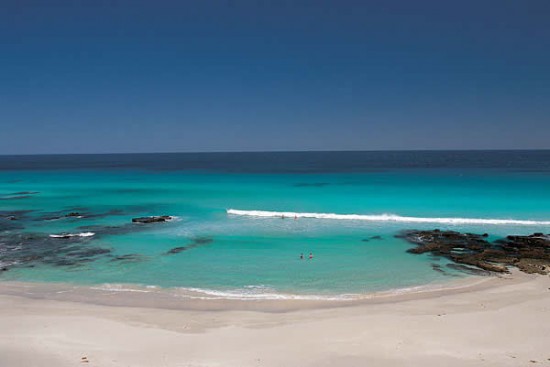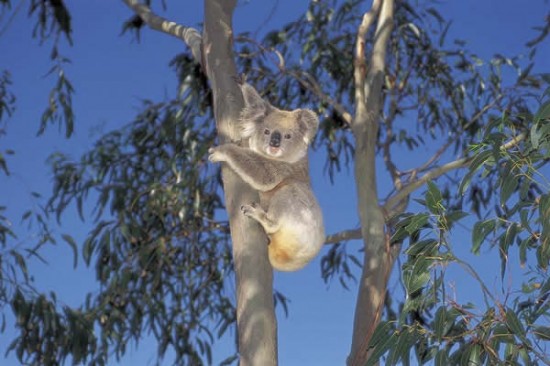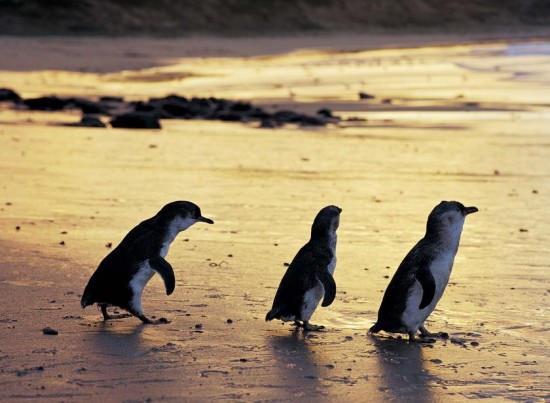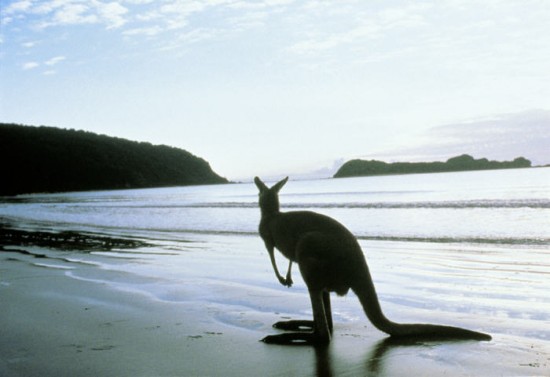Kangaroos pause from nibbling at short grass shoots to stare at you with bemused curiosity. By now, you’d think they’d be used to the sight of nightly visitors wearing crash helmets and sitting astride quad bikes, yet they still seem intrigued by such a strange procession of creatures puttering along at a polite distance from them.
Still, they’re far from domesticated. The sudden growl of a throttle will have them bounding in the opposite direction, disappearing quickly into the grey-green scrub where their dusky fur acts as perfect camouflage.
Brenton Davis has been conducting quad bike tours through his and a few neighbours’ properties near Vivonne Bay on the south coast of Kangaroo Island in South Australia since November 2007. His Kangaroo Island Outdoor Action business offers guided tours at dusk through 200 hectares of bushland trails and paddocks, with views of the ocean and the Vivonne Bay hinterland. Yet while riding the speedy quad bikes is fun, most tourists view this experience as a chance to get close to kangaroos in the wild.
“The isolation out here is special,” says Brenton. “You kill the bike’s engine and it’s just you and the roos out here. To watch them take flight across these paddocks is just magical.”
Kangaroos have been a major curiosity since the island was first settled, though not always for simple amusement and observation. When Captain Matthew Flinders discovered Kangaroo Island on March 2, 1802, his hungry crew soon learned that the short, stout kangaroos provided good food. In that first afternoon, the Investigator crew skinned and cleaned 31 kangaroos for soup and steaks. “In gratitude for so seasonable a supply,” wrote Flinders in his journal, “I named this south land Kangaroo Island.”
Often confused with wallabies because of their compact size, the Kangaroo Island Kangaroo is a subspecies of the Western Grey Kangaroo. Due to the island’s isolation and harsh winters, it evolved differently from its mainland counterparts, being smaller, darker, more robust and with longer fur. While not strictly nocturnal, the kangaroos spend much of the daylight hours sheltering in thick scrub. From late afternoon to early morning, they move out to graze in open grassy areas, also browsing on the leaves of bushes.
Feeding kangaroos, and all other wildlife, is prohibited throughout Kangaroo Island’s parks – and with good reason. Processed human food severely disrupts the nutritional balance of their natural diet, with introduced sugars increasing an undesirable fungus in kangaroos’ stomachs, causing diarrhoea. Food such as beans, peas and potato peel contain alkaloids that kill natural, beneficial bacteria living in their stomachs. Human foods can also cause dental decay and mouth infections, which lead to malnutrition.
Koalas, introduced to the island during the 1920s to prevent their extinction on the mainland and thriving in number ever since, have a different type of feeding problem. A huge migratory population, estimated to be anything from 100,000 to 400,000 animals, has destroyed large areas of eucalyptus trees that they feed on – though this is of little concern to tourists, who rate koalas as the most photogenic of Kangaroo Island’s wild animals.
 Penguins are facing a more immediate threat – and humans are not their primary concern. The Little Penguins (ITALSEudyptula minor, also known as Fairy Penguins) that mate and nest around the northern beaches of Penneshaw are the smallest of the 17 penguin species, and the only penguins that breed in Australia. However, being such a tiny animal, standing only 33cm tall at maturity, they are vulnerable to attack, and while they are prey to dogs and large seabirds, and get stressed by humans straying close to their nests, their greatest threat is another of Kangaroo Island’s primary natural tourist attractions – New Zealand fur seals.
Penguins are facing a more immediate threat – and humans are not their primary concern. The Little Penguins (ITALSEudyptula minor, also known as Fairy Penguins) that mate and nest around the northern beaches of Penneshaw are the smallest of the 17 penguin species, and the only penguins that breed in Australia. However, being such a tiny animal, standing only 33cm tall at maturity, they are vulnerable to attack, and while they are prey to dogs and large seabirds, and get stressed by humans straying close to their nests, their greatest threat is another of Kangaroo Island’s primary natural tourist attractions – New Zealand fur seals.
 As these seals are a protected species, colonies across Kangaroo Island’s southern coast have grown considerably in recent years, accounting for about 70 per cent of the pups born in Australia, and to feed such large numbers, adult seals have been hunting penguins that return to the island after lengthy ocean fishing expeditions.
As these seals are a protected species, colonies across Kangaroo Island’s southern coast have grown considerably in recent years, accounting for about 70 per cent of the pups born in Australia, and to feed such large numbers, adult seals have been hunting penguins that return to the island after lengthy ocean fishing expeditions.
Tony Trethewey has been monitoring the Penneshaw penguin colony movements for the past 25 years, recognising birds that habitually return to the same area to nest over summer, and has noticed the loss of significant numbers in recent years. A sheep farmer by day, Tony has managed the Penguins of Penneshaw interpretive centre by night, initially as a volunteer National Parks & Wildlife interpretive officer but now in the capacity of centre manager after parks authorities pulled out of the centre 12 years ago.
A simple curiosity in the birds saw Tony become the driving force in a group that has created a nesting sanctuary for the penguins, with hundreds of man-made burrows established on the Penneshaw cliffs that the birds choose to nest in each year. The efforts of volunteers to create fenced walkways and viewing platforms near the burrows have ensured that humans do not disturb the penguins.
After sunset, penguins waddle from the ocean to their nests, to mate, hatch eggs or feed hungry chicks, after a day spent hunting fish. However, they aren’t nocturnal – moving about under the cover of darkness affords them better protection from predators. More than 13,000 tourists each year pay $10 to enter (less for children and groups) the Penguins of Penneshaw centre and take a guided tour to observe this activity, and the attraction has proved a huge hit among North American and European visitors, as no penguins exist in the northern hemisphere. To prevent excessive tourist enthusiasm, the nightly interpretive walks are kept within fenced pathways, and interpretive officers shine torches with red, orange or yellow filters to observe the penguins in their nests without upsetting them. Because penguins are temporarily blinded when exposed to bright light, people are instructed not to use flash photography. They are also warned to never touch penguins, chicks, eggs or their burrows, as disturbances usually result in them abandoning their nests.
After nearly two decades, Tony can’t see an end to his involvement in the penguin centre and remains fascinated by the birds. “It’s incredible to be able to familiarise yourself with their cycle of life, and I’ve been able to do it with them living and breeding right under my nose,” he says. “In many ways, I’m just like the tourist that comes here to see these magnificent little creatures for the first time. I’m still just in awe of them.”
Photo Credits
“Kangaroo on Beach” courtesy of Tour Australia
“Kangaroos in the Grass” and “Vivenne Bay” courtesy of Tour Kangaroo Island
“Quad Adventure” courtesy of Kangaroo Island Outdoor Action
“Fairy Penguins” ABC Australia



Please Share Your Thoughts - Leave A Comment!